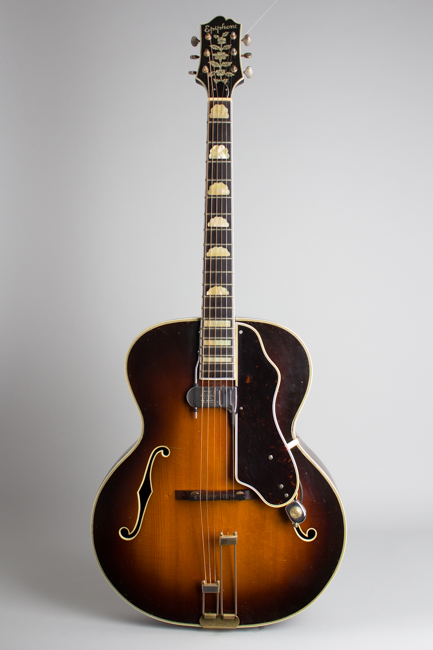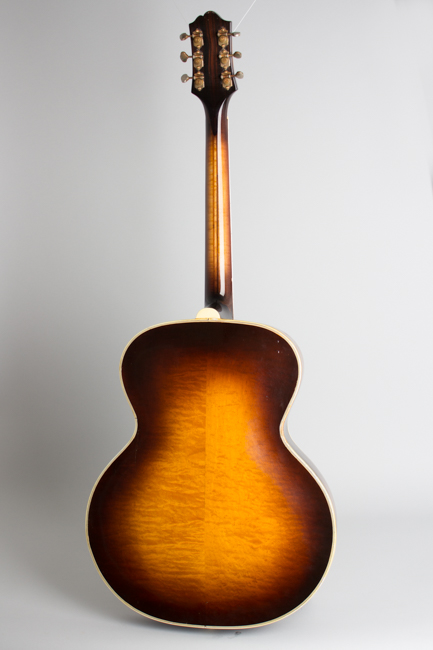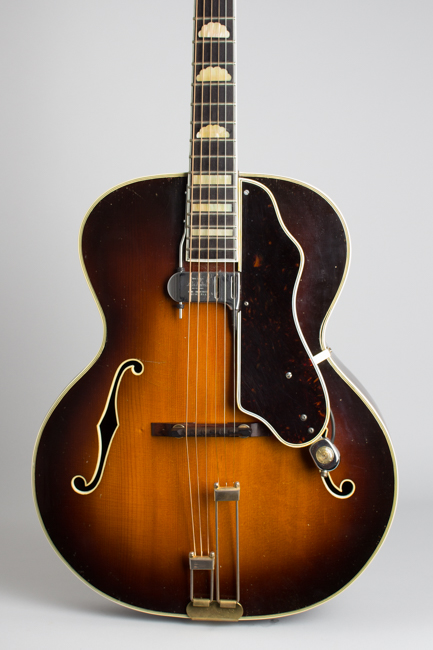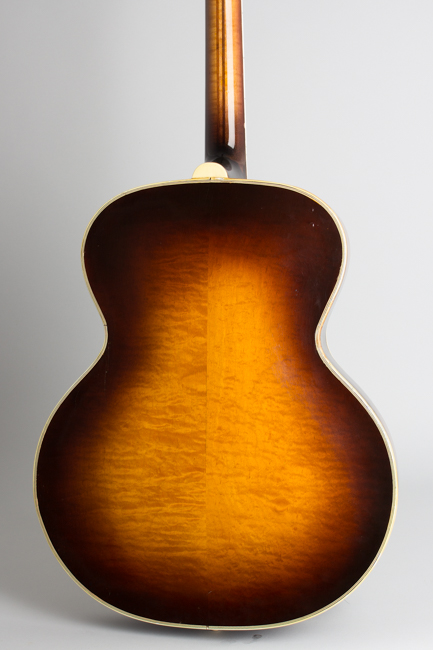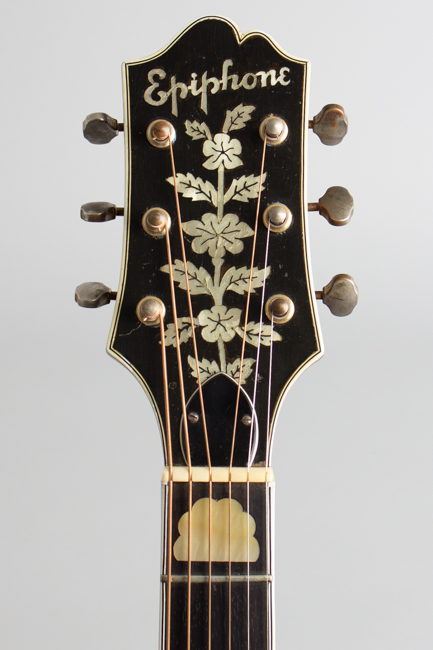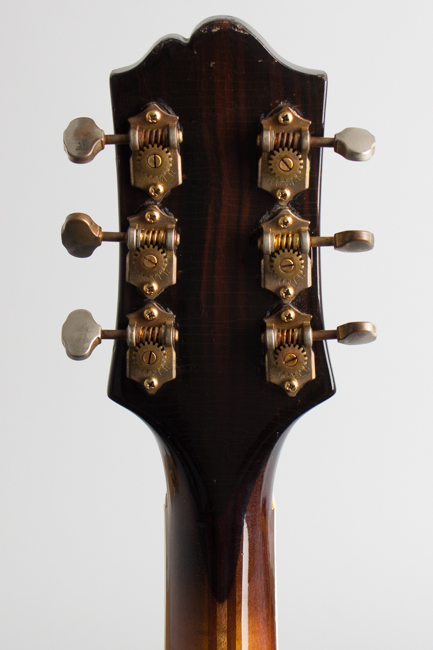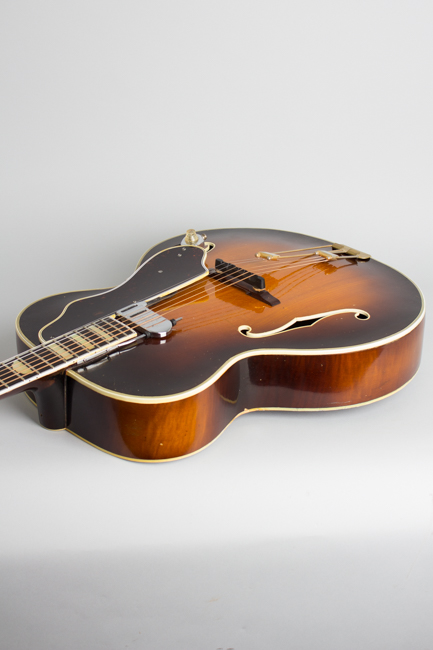Epiphone DeLuxe Arch Top Acoustic Guitar (1938)
This item has been sold.
Item # 8358
Prices subject to change without notice.
Epiphone DeLuxe Model Arch Top Acoustic Guitar (1938), made in New York City, sunburst lacquer finish, Maple back and sides, spruce top; laminated maple neck with ebony fingerboard, black hard shell case.
This is a fine-playing example of an early "second generation" Epiphone DeLuxe, developed after 1936 as the company responded to arch-rival Gibson's "Advanced" arch-top line. These original high-end acoustic arch-top Epiphone guitars were very popular among professional users when new, but nice examples are surprisingly hard to find today. This DeLuxe dates to 1938-at the time this guitar was made the Stathopoulo family maintained their guitar building operation on the second floor of a large loft building on West 14th street where Epiphone, Inc. operated an integrated factory and showroom in the heart of swing-era New York.
At that time The Deluxe, as well as the newly introduced inch-larger and even fancier Emperor, was among the very finest orchestral guitars available. They competed directly with the Gibson L-5 and Super 400 and individually built creations from John D'Angelico (about 20 minutes walk downtown), Willy Wilkanowski (a subway ride out to Greenpoint, Brooklyn), and Charles & Elmer Stromberg (a few hours north in Boston). The Epiphone company was headed up by Epaminondas ("Epi") Stathopoulo until his death in 1943. By all accounts he was an extremely fastidious and dedicated man, who personally inspected every instrument. All high-end carved-top Epiphone guitars are fine instruments, but those produced under his watch are among the very best and were often preferred by the era's top players to anything else available.
This Deluxe is an transitional example of the more refined, "perfected" swing-era version, larger and sleeker than the original 1931-style "Masterbilt" style. The 5-piece laminated neck is slimmer than older models, with a profile halfway between a "C" and "V". The headstock is still the older "offset peak" style, with the newer fancy "tree of life" inlay on the face. The peghead profile would be enlarged and straightened out the next year. The elegant practice of veneering the back of the peghead with rosewood ended soon after as well.
The 17 3/8" wide body is bound in 5-ply celluloid and the finish is a fairly dark sunburst still showing off some fairly deep curl on the maple back. The sound is both rich and powerful, with the definition old Epiphones are known for. We are always pleased to offer these top-line Epiphones, especially pre-war ones. They are not only great guitars, but a huge part of our New York area musical heritage.
Overall length is 42 in. (106.7 cm.), 17 3/8 in. (44.1 cm.) wide at lower bout, and 3 7/16 in. (8.7 cm.) in depth, measured at side of rim. Scale length is 25 1/2 in. (648 mm.). Width of nut is 1 11/16 in. (43 mm.). This is an excellent playing pre-war DeLuxe, now just hitting its 80th birthday. Over the years it has definitely been played but well cared for with some modifications but remains a lovely example of Epiphone's finest work. This guitar has been adapted in the traditional manner for use as an electric instrument without affecting the acoustic properties, and excels in either role.
The most obvious change is a Gibson style adjustable truss rod has been fitted in place of the sometimes ineffective original Epiphone "thrust" rod. This change is indicated by a small cover added in the typical spot at the base of the headstock face. As a result the fingerboard itself is a replacement, made of very fine ebony in place of the original rosewood and inlaid with Epiphone's post-war style non-segmented pearl "cloud" blocks. There are also extra straight blocks at the 17th and 19th fret positions. The frets are a bit wider than the original style but nicely done. The back of the neck has a clean overspray as well. This work is all very well done, and fairly discreet visually but makes keeping the guitar adjusted for optimum playability a much easier proposition.
The pickguard is an exact replacement in the correct style, and is set up with a DeArmond "Guitar mike" pickup with the volume control box and connector at the lower tip. The pickup is solidly mounted to the side of the neck with the traditional bracket but the entire assembly could be removed if desired. The tuners are modern repros of the original openback Grovers. The tailpiece is original and shows no metal fatigue issues to the baseplate, which is rare today. The bridge is a 1950's Gibson style two-foot affair.
The finish shows some light checking and minor wear overall but apart from the back of the neck appears all original. The outer layer of binding only on the back shows some shrinkage and minor deterioration, but nothing that affects playability. All other binding shows no distress. There is one small crack to the back off the treble side waist, quite inconspicuous. The heel has a hole for a strap button-we would be happy to either replace the button or fill this as desired.
Overall this is an excellent player's instrument, perhaps not a collector's grade choice but a fine guitar in both acoustic and electric modes. The neck is slimmer than many pre-war archtops, but the sound is still big with the expected cutting power but still a fine roundness to it. It is priced somewhat lower than an all-original example would be but in many ways represents a more practical gigging instrument for the active player. Ready to go, including a modern Gretsch HSC. Excellent - Condition.
This is a fine-playing example of an early "second generation" Epiphone DeLuxe, developed after 1936 as the company responded to arch-rival Gibson's "Advanced" arch-top line. These original high-end acoustic arch-top Epiphone guitars were very popular among professional users when new, but nice examples are surprisingly hard to find today. This DeLuxe dates to 1938-at the time this guitar was made the Stathopoulo family maintained their guitar building operation on the second floor of a large loft building on West 14th street where Epiphone, Inc. operated an integrated factory and showroom in the heart of swing-era New York.
At that time The Deluxe, as well as the newly introduced inch-larger and even fancier Emperor, was among the very finest orchestral guitars available. They competed directly with the Gibson L-5 and Super 400 and individually built creations from John D'Angelico (about 20 minutes walk downtown), Willy Wilkanowski (a subway ride out to Greenpoint, Brooklyn), and Charles & Elmer Stromberg (a few hours north in Boston). The Epiphone company was headed up by Epaminondas ("Epi") Stathopoulo until his death in 1943. By all accounts he was an extremely fastidious and dedicated man, who personally inspected every instrument. All high-end carved-top Epiphone guitars are fine instruments, but those produced under his watch are among the very best and were often preferred by the era's top players to anything else available.
This Deluxe is an transitional example of the more refined, "perfected" swing-era version, larger and sleeker than the original 1931-style "Masterbilt" style. The 5-piece laminated neck is slimmer than older models, with a profile halfway between a "C" and "V". The headstock is still the older "offset peak" style, with the newer fancy "tree of life" inlay on the face. The peghead profile would be enlarged and straightened out the next year. The elegant practice of veneering the back of the peghead with rosewood ended soon after as well.
The 17 3/8" wide body is bound in 5-ply celluloid and the finish is a fairly dark sunburst still showing off some fairly deep curl on the maple back. The sound is both rich and powerful, with the definition old Epiphones are known for. We are always pleased to offer these top-line Epiphones, especially pre-war ones. They are not only great guitars, but a huge part of our New York area musical heritage.
Overall length is 42 in. (106.7 cm.), 17 3/8 in. (44.1 cm.) wide at lower bout, and 3 7/16 in. (8.7 cm.) in depth, measured at side of rim. Scale length is 25 1/2 in. (648 mm.). Width of nut is 1 11/16 in. (43 mm.). This is an excellent playing pre-war DeLuxe, now just hitting its 80th birthday. Over the years it has definitely been played but well cared for with some modifications but remains a lovely example of Epiphone's finest work. This guitar has been adapted in the traditional manner for use as an electric instrument without affecting the acoustic properties, and excels in either role.
The most obvious change is a Gibson style adjustable truss rod has been fitted in place of the sometimes ineffective original Epiphone "thrust" rod. This change is indicated by a small cover added in the typical spot at the base of the headstock face. As a result the fingerboard itself is a replacement, made of very fine ebony in place of the original rosewood and inlaid with Epiphone's post-war style non-segmented pearl "cloud" blocks. There are also extra straight blocks at the 17th and 19th fret positions. The frets are a bit wider than the original style but nicely done. The back of the neck has a clean overspray as well. This work is all very well done, and fairly discreet visually but makes keeping the guitar adjusted for optimum playability a much easier proposition.
The pickguard is an exact replacement in the correct style, and is set up with a DeArmond "Guitar mike" pickup with the volume control box and connector at the lower tip. The pickup is solidly mounted to the side of the neck with the traditional bracket but the entire assembly could be removed if desired. The tuners are modern repros of the original openback Grovers. The tailpiece is original and shows no metal fatigue issues to the baseplate, which is rare today. The bridge is a 1950's Gibson style two-foot affair.
The finish shows some light checking and minor wear overall but apart from the back of the neck appears all original. The outer layer of binding only on the back shows some shrinkage and minor deterioration, but nothing that affects playability. All other binding shows no distress. There is one small crack to the back off the treble side waist, quite inconspicuous. The heel has a hole for a strap button-we would be happy to either replace the button or fill this as desired.
Overall this is an excellent player's instrument, perhaps not a collector's grade choice but a fine guitar in both acoustic and electric modes. The neck is slimmer than many pre-war archtops, but the sound is still big with the expected cutting power but still a fine roundness to it. It is priced somewhat lower than an all-original example would be but in many ways represents a more practical gigging instrument for the active player. Ready to go, including a modern Gretsch HSC. Excellent - Condition.
